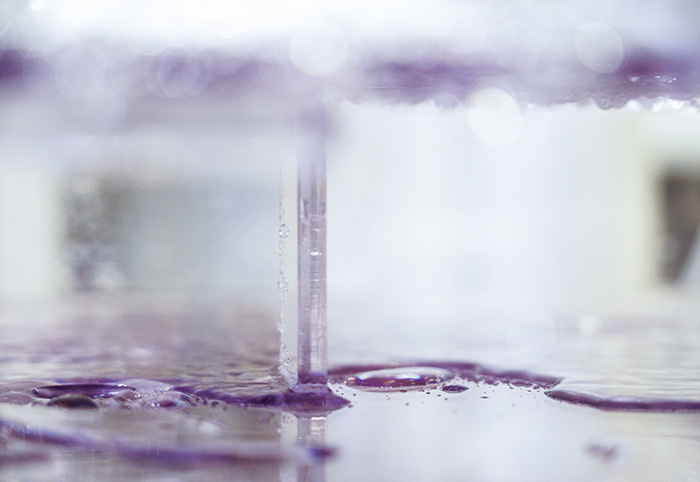Water
Tackling the challenges of water scarcity and wastewater treatment has been part of our strategy since 1993. Water plays a key role in the manufacturing of semiconductors. Our processes require ultrapure water and generate wastewater that can be harmful to the environment and local communities. Our comprehensive management approach includes water stress assessment, conservation programs, water efficiency and wastewater treatment. I 103-1 I
Assessing and monitoring our impact
Water is a limited and shared resource, and we take responsibility for all water-related challenges wherever we operate. A reliable water supply is essential to the semiconductor manufacturing process. All ST sites manage their water-related risks according to their needs and water availability. Each site monitors the volume of water it uses and complies with local permits. One of our manufacturing sites uses groundwater for its operations. In 2021, 13% of the water used throughout our operations came from groundwater and 87% from municipal water supplies. I 303-3 I
Water withdrawal by source in 2021 (%) I 303-3 I SDG 6.4
As most of our primary water supply is local municipal water, it is fundamental to ensure the continuity of water supplies in the areas where we operate. We therefore engage in regular discussions with local stakeholders and implement solutions to reduce water extraction and consumption. In 2021, we conducted a water assessment with an external partner to assess our global water footprint and identify water stress areas, water-related risks of our operations, and our impact on local communities.
FOCUS

Assessing water-related risks
In 2021, ST conducted a water risk assessment at corporate level for all our manufacturing sites. The aim was to identify our overall water footprint and assess operational and external water-related risks. Partnering with Quantis, we took the lifecycle assessment approach to evaluate our indirect impacts linked to upstream and downstream activities, and our direct impacts linked to our manufacturing operations.
We analyzed the external factors for each site, depending on its location, applying the Water Risk Filter 5.0 methodology. As a result, we identified that most of our manufacturing sites are at medium risk for both operational and external risks. This study confirmed that water scarcity and water quality are external physical risks, while the importance of water in our operations and the production of ultrapure water are drivers of our operational risks. As a next step, each site will consider risk level and type to formalize appropriate water saving action plans.

Tatiana Fedotova
Global Water Lead, Quantis
Water and climate risks are a priority for ST. ST partnered with Quantis to update their water and carbon footprints, conduct risk assessments, and engage with all manufacturing sites to ensure the corporate water strategy addressed differing local contexts. The next phase will be to work with suppliers and step up commitments to address impacts in water-stressed basins.”
Reducing our water use
Water efficiency
Our manufacturing processes require ultrapure water. We apply the best available water-producing techniques that meet the required purity levels while minimizing water use.
16%
reduction in water consumption
We aim to reduce our water use by continuously improving water efficiency across our operations. In 2021, we reduced our water consumption per unit of production by 16% compared to 2020, in line with our 2025 target to reduce our water consumption by 20% vs 2016. This is the result of the continuous efforts of all our manufacturing sites and teams.
For example, our Crolles site (France) initiated a working group with the facilities teams to reduce water consumption at source. By optimizing idle equipment modes, the site decreased water use by 4%. Other initiatives led to a 17% reduction in their global water consumption per unit of production, versus 2020.
In Morocco, where water is a particularly scarce resource, our Bouskoura site has implemented several action plans to reduce its water consumption and increase the water recycling rate for a number of years. In 2021, the site reduced its absolute water consumption by 6.5%. In one initiative open cooling towers were replaced with closed cooling towers.
Our Shenzhen site (China) improved its water efficiency in 2021 by deploying several actions, such as optimizing nozzles for rinsing operations and recycling flux rinse water.
Water recycling
40%
of water recycled and reused
In 2021, our water recycling rate reached 40% compared to 41% in 2020. This is mainly because of our requirements for ultrapure water, which significantly increased at our front-end manufacturing sites due to higher production volumes.
One of our main approaches to overall water conservation is to reuse and recycle. However, as we use ultrapure water in our processes, it is not always possible to reuse processed water. Although water can be treated and recycled into ultrapure water, it is more often reused to cover facility needs, such as cooling towers and scrubbers.
To improve its low water recycling rate, our Calamba site (the Philippines) continued a project initiated in 2020 to recover and treat water from manufacturing processes for use in the cooling towers. As a result, the site increased its recycling rate from 22% to 38%.
Efficient wastewater treatment
Wastewater from our manufacturing processes contains pollutants such as heavy metals and toxic solvents. To mitigate any risk of pollution, wastewater needs to be treated on site or in municipal treatment plants before being discharged back into the natural environment. Wastewater treatment involves physical, chemical, or biological processes. The quality of the discharged water is carefully controlled.
Our manufacturing sites are continually looking for ways to improve wastewater treatment and water discharge quality to minimize our impact on the environment.
As well as reducing the risk of pollution, optimizing wastewater treatment helps improve recycling efficiency, and so reduces the amount of water withdrawn. Further to the redesign of its wastewater treatment plant, our Bouskoura site (Morocco) improved its water recycling rate from 33% in 2019 to 53% in 2021.
Our Kirkop site (Malta) launched an original and innovative project to address heavy metals. The site initiated a program with the University of Alessandria (Italy) to study the effectiveness and efficiency of using phytoremediation to treat a drain containing heavy metals from plating. In this process, plants clean the wastewater by absorbing the metals through their roots. If successful, this method can potentially be used at other ST sites.
Typical ST water cycle
Transparency disclosure
We have participated in the CDP since 2004 with the aim of sharing our water management performance transparently with all our stakeholders, including the associated risks and opportunities. It also allows us to compare our progress with peers in the semiconductor industry and identify improvement areas. In 2021, we received a B rating. This is lower than the previous year, but still higher than the sector average of B-. Based on the analysis of the results, we focused more on water-related risks in 2021 and plan to reinforce our water policy in 2022.
Contributing to the Sustainable Development Goals
Our commitments and programs related to Water as described above contribute to:
SDG target 6.4 – Substantially increase water-use efficiency across all sectors and ensure sustainable withdrawals and supply of freshwater to address water scarcity.
SDG target 8.4 – Improve progressively, through 2030, global resource efficiency in consumption and production.
2025 sustainability goal |
Status |
Comments |
SG13: Improve our water efficiency by 20% by 2025 vs 2016. |
-11% |
Annual sustainability goal |
Status |
Comments |
SG14: Recycle at least 50% of the water used each year. |
40% |


